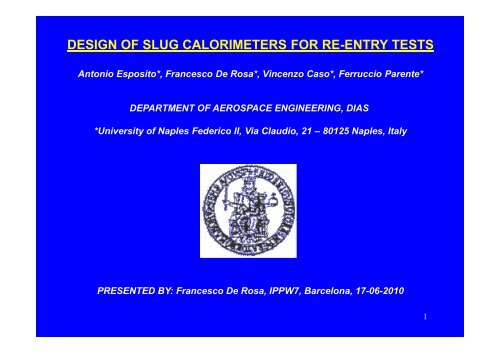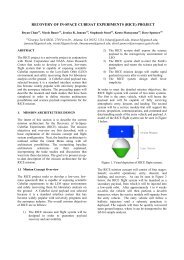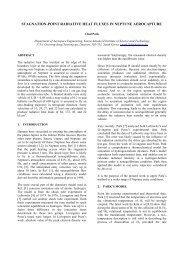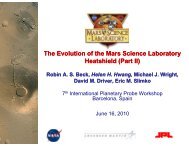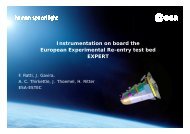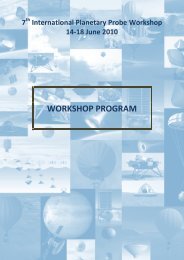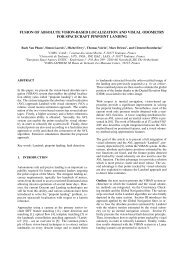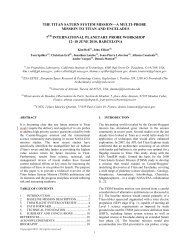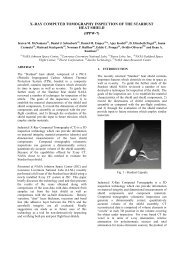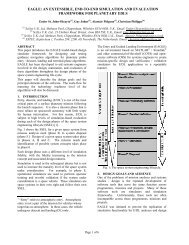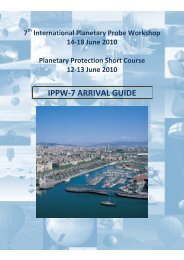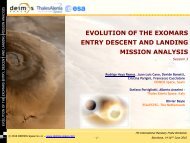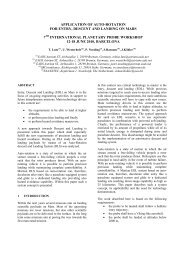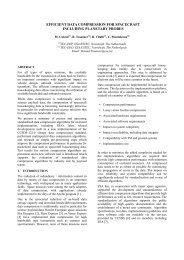design of slug calorimeters for re-entry tests - International Planetary ...
design of slug calorimeters for re-entry tests - International Planetary ...
design of slug calorimeters for re-entry tests - International Planetary ...
Create successful ePaper yourself
Turn your PDF publications into a flip-book with our unique Google optimized e-Paper software.
DESIGN OF SLUG CALORIMETERS FOR RE-ENTRY TESTS<br />
Antonio Esposito*, Francesco De Rosa*, Vincenzo Caso*, Ferruccio Pa<strong>re</strong>nte*<br />
DEPARTMENT OF AEROSPACE ENGINEERING, DIAS<br />
*University <strong>of</strong> Naples Federico II, Via Claudio, 21 – 80125 Naples, Italy<br />
PRESENTED BY: Francesco De Rosa, IPPW7, Barcelona, 17-06-2010<br />
1
DESIGN OF SLUG CALORIMETERS FOR RE-ENTRY TESTS<br />
Antonio Esposito, Francesco De Rosa, Vincenzo Caso, Ferruccio Pa<strong>re</strong>nte DIAS, University <strong>of</strong> Naples Federico II, Via Claudio, 21 – 80125 Naples, Italy<br />
PRESENTED BY: Francesco De Rosa, IPPW7, Barcelona, 17-06-2010<br />
1. INTRODUCTION<br />
The paper deals with the <strong>design</strong>, manufacturing and test <strong>of</strong> “<strong>slug</strong>” <strong>calorimeters</strong>, both <strong>for</strong> ground testing as <strong>for</strong><br />
dynamic and flight testing whe<strong>re</strong> the magnitude and duration <strong>of</strong> heating <strong>re</strong>qui<strong>re</strong> a thick <strong>slug</strong> equipped with several<br />
thermocouples due to the app<strong>re</strong>ciable internal temperatu<strong>re</strong> gradients. It is discussed the possibility <strong>of</strong> using a<br />
single thermocouple application on thick <strong>slug</strong> <strong>calorimeters</strong> subjected to heating rates in the range from 50 to 250<br />
[kW/m 2 ] keeping an acceptable engineering approximation. In fact, it has been found that the equation:<br />
q<br />
<br />
c<br />
l<br />
<br />
dT<br />
dt<br />
(Eq.1)<br />
whe<strong>re</strong> r, c and l a<strong>re</strong> <strong>re</strong>spectively density, specific heat and length <strong>of</strong> the <strong>slug</strong>, <strong>for</strong> a thick OFHC Copper<br />
calorimeter yields heat-rate values very close to the input, provided the temperatu<strong>re</strong> measu<strong>re</strong>ments we<strong>re</strong> made<br />
at a distance from the back face <strong>of</strong> the <strong>slug</strong> equal to 60 percent <strong>of</strong> the length, this condition held true <strong>for</strong> a<br />
variety <strong>of</strong> inputs, both constant and varying. This method, <strong>re</strong>quiring a single-point measu<strong>re</strong>ment per<br />
calorimeter, substantially <strong>re</strong>duces time and costs involved in investigations <strong>of</strong> both varying and constant high<br />
heat fluxes .<br />
2
DESIGN OF SLUG CALORIMETERS FOR RE-ENTRY TESTS<br />
Antonio Esposito, Francesco De Rosa, Vincenzo Caso, Ferruccio Pa<strong>re</strong>nte DIAS, University <strong>of</strong> Naples Federico II, Via Claudio, 21 – 80125 Naples, Italy<br />
PRESENTED BY: Francesco De Rosa, IPPW7, Barcelona, 17-06-2010<br />
2. SLUG BASIC THEORY<br />
The <strong>slug</strong>-type heat-flux sensor consists <strong>of</strong> a small cylinder <strong>of</strong><br />
metallic material (<strong>slug</strong>) fitted into the exposed face <strong>of</strong> the model but<br />
isolated from it to minimize the heat losses to and from the model in<br />
order to approximate the heat transfer as one-dimensional.<br />
l<br />
q<br />
c<br />
l<br />
<br />
dT<br />
dt<br />
(Eq.1)<br />
In case <strong>of</strong> thin <strong>slug</strong>s with nonsignificant<br />
temperatu<strong>re</strong><br />
gradients a single thermocouple<br />
located on the <strong>re</strong>ar surface <strong>of</strong> the<br />
<strong>slug</strong> is sufficient to measu<strong>re</strong> the<br />
temperatu<strong>re</strong><br />
l<br />
In case <strong>of</strong> thick <strong>slug</strong>s with<br />
significant temperatu<strong>re</strong><br />
gradients<br />
several<br />
thermocouples located in<br />
diffe<strong>re</strong>nt positions a<strong>re</strong> needed<br />
to monitor the temperatu<strong>re</strong><br />
itself<br />
The measu<strong>re</strong>ment <strong>of</strong> a constant heat flux<br />
is per<strong>for</strong>med starting from a <strong>re</strong>fe<strong>re</strong>nce<br />
temperatu<strong>re</strong>, then the sensor is inserted<br />
into the st<strong>re</strong>am. After a short initial<br />
transient the temperatu<strong>re</strong> inc<strong>re</strong>ases<br />
linearly versus time allowing <strong>for</strong><br />
temperatu<strong>re</strong> tracking <strong>for</strong> a time<br />
sufficiently long to enable accurate<br />
determination <strong>of</strong> the derivative dT/dt but<br />
not too long to not compromise the<br />
physical integrity <strong>of</strong> the sensor. At this<br />
point the sensor is <strong>re</strong>moved from the flow<br />
continuing to acqui<strong>re</strong> temperatu<strong>re</strong> data.<br />
3
DESIGN OF SLUG CALORIMETERS FOR RE-ENTRY TESTS<br />
Antonio Esposito, Francesco De Rosa, Vincenzo Caso, Ferruccio Pa<strong>re</strong>nte DIAS, University <strong>of</strong> Naples Federico II, Via Claudio, 21 – 80125 Naples, Italy<br />
PRESENTED BY: Francesco De Rosa, IPPW7, Barcelona, 17-06-2010<br />
3. SLUG DESIGN PRINCIPLES<br />
The choice <strong>of</strong> the material used to build the <strong>slug</strong> involves several considerations<br />
but the key role is played by the melting temperatu<strong>re</strong> <strong>of</strong> the exposed surface.<br />
When the surface <strong>of</strong> the calorimeter is suddenly<br />
exposed to a high heat flow, this is initially transmitted<br />
by conduction. The melting does not occur until the<br />
surface <strong>re</strong>aches a critical temperatu<strong>re</strong>, which depends<br />
on the structu<strong>re</strong> <strong>of</strong> the material. When the melting<br />
begins, the flow by conduction is <strong>re</strong>duced and a large<br />
portion <strong>of</strong> energy is sto<strong>re</strong>d into the phase changing. In<br />
this situation the <strong>re</strong>lationship between the heat flux and<br />
the temperatu<strong>re</strong> <strong>of</strong> the back surface becomes very<br />
complex. The classical solution <strong>of</strong> the heat conduction<br />
on a semi-infinite solid exposed to a sudden constant<br />
heat flux can be used to determine the properties<br />
necessary to avoid melting. The time <strong>re</strong>qui<strong>re</strong>d to achieve<br />
the melting, t mp , is obtained in the following <strong>for</strong>mula:<br />
t<br />
mp<br />
k c<br />
T<br />
<br />
2<br />
4q<br />
2<br />
mp<br />
(Eq.2)<br />
Materials with high values <strong>of</strong> k, ρ, c and ΔT mp allow,<br />
under the same heat flux, <strong>for</strong> longer exposu<strong>re</strong> to flow<br />
(ΔT mp is the necessary temperatu<strong>re</strong> inc<strong>re</strong>ase to <strong>re</strong>ach<br />
surface melting).<br />
Copper is typically a good compromise <strong>for</strong> its low cost<br />
(compa<strong>re</strong>d to other materials), easy machinability and<br />
large availability.<br />
Element / Material T mp k r c k r c T mp<br />
Symb Name [°C] [ W m -1 °C -1 ] [kg m -3 ] [J kg -1 °C -1 ] [W 2 s m -4 °C -1 ]<br />
Pb Lead 328 35,3 11350 130 1,71E+10<br />
Inconel 625LCF 1290 9,7 8440 410 4,33E+10<br />
Steel 661 1300 12,3 8250 435 5,74E+10<br />
Inconel 600 1355 14,9 8470 444 7,59E+10<br />
Ti Titanium 1660 21,9 4540 520 8,58E+10<br />
Steel 302 1400 16,2 7860 500 8,91E+10<br />
Zn Zinc 420 116,0 7130 390 1,35E+11<br />
Ta Tantalum 1996 57,5 16650 140 2,68E+11<br />
Brass CuZn40Pb2 850 111,0 8430 380 3,02E+11<br />
Pt Platinum 1772 71,6 21450 130 3,54E+11<br />
Al Aluminum 660 237,0 2702 900 3,81E+11<br />
Re Rhenium 3180 47,9 21040 130 4,17E+11<br />
Fe Iron 1535 80,2 7874 440 4,27E+11<br />
Ni Nickel 1453 90,7 8900 440 5,16E+11<br />
C* *Graphite 3500 129,0 2260 710 7,24E+11<br />
Os Osmium 3027 87,6 22600 130 7,79E+11<br />
Au Gold 1065 317,0 19320 128 8,35E+11<br />
Be Beryllium 1278 201,0 1848 1820 8,64E+11<br />
Mo Molybdenum 2617 138,0 10220 250 9,23E+11<br />
Ag Silver 961 429,0 10500 235 1,02E+12<br />
Cu Copper 1085 401,0 8960 380 1,48E+12<br />
W Tungsten 3407 174,0 19350 130 1,49E+12<br />
C** **Diamond 3547 2200,0 3500 630 1,72E+13<br />
4
DESIGN OF SLUG CALORIMETERS FOR RE-ENTRY TESTS<br />
Antonio Esposito, Francesco De Rosa, Vincenzo Caso, Ferruccio Pa<strong>re</strong>nte DIAS, University <strong>of</strong> Naples Federico II, Via Claudio, 21 – 80125 Naples, Italy<br />
PRESENTED BY: Francesco De Rosa, IPPW7, Barcelona, 17-06-2010<br />
3. SLUG DESIGN PRINCIPLES cont’d<br />
Slug material vs application:<br />
t<br />
mp<br />
k c<br />
T<br />
<br />
2<br />
4q<br />
2<br />
mp<br />
(Eq.2)<br />
Element / Material T mp k r c k r c T mp<br />
Case 1) Re-<strong>entry</strong> flight. Slugs annealed into<br />
thermal shield. Key factors a<strong>re</strong>:<br />
-Weight <strong>of</strong> <strong>calorimeters</strong><br />
-Weight <strong>of</strong> wiring<br />
-Cost <strong>of</strong> raw materials and fabrication<br />
-Cost <strong>of</strong> payload ($/kg)<br />
-Slugs a<strong>re</strong> typically non-<strong>re</strong>usable<br />
Case 2) Re-<strong>entry</strong> lab test. Slugs annealed<br />
into a probe or scaled proto. Key factors<br />
a<strong>re</strong>:<br />
-Cost <strong>of</strong> materials and fabrication<br />
-Slug a<strong>re</strong> typically <strong>re</strong>-usable<br />
Symb Name [°C] [ W m -1 °C -1 ] [kg m -3 ] [J kg -1 °C -1 ] [W 2 s m -4 °C -1 ]<br />
Pb Lead 328 35,3 11350 130 1,71E+10<br />
Inconel 625LCF 1290 9,7 8440 410 4,33E+10<br />
Steel 661 1300 12,3 8250 435 5,74E+10<br />
Inconel 600 1355 14,9 8470 444 7,59E+10<br />
Ti Titanium 1660 21,9 4540 520 8,58E+10<br />
Steel 302 1400 16,2 7860 500 8,91E+10<br />
Zn Zinc 420 116,0 7130 390 1,35E+11<br />
Ta Tantalum 1996 57,5 16650 140 2,68E+11<br />
Brass CuZn40Pb2 850 111,0 8430 380 3,02E+11<br />
Pt Platinum 1772 71,6 21450 130 3,54E+11<br />
Al Aluminum 660 237,0 2702 900 3,81E+11<br />
Re Rhenium 3180 47,9 21040 130 4,17E+11<br />
Fe Iron 1535 80,2 7874 440 4,27E+11<br />
Ni Nickel 1453 90,7 8900 440 5,16E+11<br />
C* *Graphite 3500 129,0 2260 710 7,24E+11<br />
Os Osmium 3027 87,6 22600 130 7,79E+11<br />
Au Gold 1065 317,0 19320 128 8,35E+11<br />
Be Beryllium 1278 201,0 1848 1820 8,64E+11<br />
Mo Molybdenum 2617 138,0 10220 250 9,23E+11<br />
Ag Silver 961 429,0 10500 235 1,02E+12<br />
Cu Copper 1085 401,0 8960 380 1,48E+12<br />
W Tungsten 3407 174,0 19350 130 1,49E+12<br />
C** **Diamond 3547 2200,0 3500 630 1,72E+13<br />
5
DESIGN OF SLUG CALORIMETERS FOR RE-ENTRY TESTS<br />
Antonio Esposito, Francesco De Rosa, Vincenzo Caso, Ferruccio Pa<strong>re</strong>nte DIAS, University <strong>of</strong> Naples Federico II, Via Claudio, 21 – 80125 Naples, Italy<br />
PRESENTED BY: Francesco De Rosa, IPPW7, Barcelona, 17-06-2010<br />
4. SLUG THEORY FOR CONSTANT AND VARYING HEAT FLUXES<br />
For the one-dimensional heat flow case, the calorimeter is<br />
conside<strong>re</strong>d to be a solid bounded by a pair <strong>of</strong> parallel planes at x =0<br />
and x =l. The solid is heated uni<strong>for</strong>mly at x =l with a constant input<br />
and with no heat loss. The well-know solution <strong>of</strong> Carslaw and<br />
Jaeger, see paper <strong>re</strong>f [8], <strong>for</strong> the temperatu<strong>re</strong> field <strong>re</strong>duces to the<br />
Eq.1 when time becomes large enough. Following McDonough and<br />
Youngbluth, see paper <strong>re</strong>f [9], if an average or effective temperatu<strong>re</strong><br />
could be determined and shown to occur at a particular location in<br />
the calorimeter, a temperatu<strong>re</strong> measu<strong>re</strong>ment made at this point<br />
would yield a <strong>re</strong>liable average dT/dt to be used in the Eq. 1.<br />
This measu<strong>re</strong>ment can be made when the specific heat is a linear<br />
function <strong>of</strong> temperatu<strong>re</strong> over the range established by the<br />
temperatu<strong>re</strong> gradient in the calorimeter. It can be proven<br />
theo<strong>re</strong>tically and has been he<strong>re</strong>inafter proven experimentally that<br />
the location <strong>of</strong> the average temperatu<strong>re</strong> is given by the Eq.3 as<br />
measu<strong>re</strong>d from the back face <strong>of</strong> the calorimeter.<br />
It can be also proven that the time derivative <strong>of</strong> the average <strong>slug</strong><br />
temperatu<strong>re</strong> is a constant and after the transient period is over, it is<br />
independent <strong>of</strong> position along l. Because <strong>of</strong> the <strong>re</strong>qui<strong>re</strong>ment that<br />
the transient disappear be<strong>for</strong>e valid data can be obtained, a<br />
characteristic minimum <strong>re</strong>sponse time is necessary to p<strong>re</strong>dict the<br />
calorimeter per<strong>for</strong>mance. Such a time may be defined as in Eq.4.<br />
Since a is a function <strong>of</strong> temperatu<strong>re</strong>, the actual <strong>re</strong>sponse time <strong>of</strong> the<br />
calorimeter depends on the temperatu<strong>re</strong> rise during the transient<br />
period which in depends on the input. In every application, ca<strong>re</strong><br />
should be taken to consider the temperatu<strong>re</strong> sensitivity <strong>of</strong> the<br />
particular <strong>slug</strong> material and the expected input when estimating the<br />
<strong>re</strong>sponse time <strong>of</strong> the calorimeter.<br />
(*TC=Thermocouple)<br />
MULTI-TC*<br />
Define T AV<br />
x 0.6l<br />
(Eq. 3)<br />
<br />
<br />
2l<br />
2<br />
2<br />
<br />
SINGLE-TC*<br />
along the <strong>slug</strong><br />
(Eq. 4)<br />
6
DESIGN OF SLUG CALORIMETERS FOR RE-ENTRY TESTS<br />
Antonio Esposito, Francesco De Rosa, Vincenzo Caso, Ferruccio Pa<strong>re</strong>nte DIAS, University <strong>of</strong> Naples Federico II, Via Claudio, 21 – 80125 Naples, Italy<br />
PRESENTED BY: Francesco De Rosa, IPPW7, Barcelona, 17-06-2010<br />
5. SINGLE-THERMOCOUPLE THICK SLUG vs SCHMIDT-BOELTER (CONSTANT HEAT FLUX)<br />
In order to validate the heat flux measu<strong>re</strong>ment made by the thick single-thermocouple Slug, the test matrix cove<strong>re</strong>d using the Slug<br />
itself was <strong>re</strong>peated measuring the heat fluxes by a Schmidt-Boelter calibrated probe. The Slug calorimeter was hand-crafted in<br />
laboratory as a cylinder <strong>of</strong> OFHC copper f=10[mm], l=10[mm]. The insulation is a low-conductivity ceramic. A Chromel-Alumel (K type)<br />
thermocouple is solde<strong>re</strong>d at 60% <strong>of</strong> its length as p<strong>re</strong>viously shown. The Schmidt-Boelter gauge used is the SBG01-200 model from<br />
Hukseflux.<br />
SMALL<br />
PLANETARY<br />
ENTRY<br />
SIMULATOR<br />
SPES<br />
FACILITY AT<br />
UNIVERSITY<br />
OF NAPLES<br />
SLUG<br />
S-B<br />
SPES<br />
TYPICAL<br />
FLOW<br />
PARAMETERS<br />
PROBE TESTED INTO SPES FACILITY(ARGON)<br />
7
DESIGN OF SLUG CALORIMETERS FOR RE-ENTRY TESTS<br />
Antonio Esposito, Francesco De Rosa, Vincenzo Caso, Ferruccio Pa<strong>re</strong>nte DIAS, University <strong>of</strong> Naples Federico II, Via Claudio, 21 – 80125 Naples, Italy<br />
PRESENTED BY: Francesco De Rosa, IPPW7, Barcelona, 17-06-2010<br />
5. SINGLE-THERMOCOUPLE THICK SLUG vs SCHMIDT-BOELTER (CONSTANT HEAT FLUX) cont’d<br />
Most significant <strong>re</strong>sults a<strong>re</strong> he<strong>re</strong>inafter show <strong>for</strong> steady heat flux.<br />
Heat F lux [kW/m 2 ]<br />
300<br />
250<br />
200<br />
150<br />
100<br />
50<br />
0<br />
S c hmidt-B oelter vs S lug<br />
0 0,2 0,4 0,6 0,8 1 1,2<br />
Arc G a s F low [g /s]<br />
I=150 A<br />
qS B<br />
qS lug<br />
qZoby<br />
Heat F lux [kW/m 2 ]<br />
S c hmidt-B oelter vs S lug<br />
300<br />
m g as =0,5 g/s<br />
250<br />
200<br />
qS B<br />
150<br />
100<br />
qS lug<br />
50<br />
qZoby<br />
0<br />
120 140 160 180 200 220<br />
Arc C ur<strong>re</strong>nt [A]<br />
Heat F lux [kW/m 2 ]<br />
300<br />
250<br />
200<br />
150<br />
100<br />
50<br />
0<br />
S c hmidt-B oelter vs S lug<br />
0 0,2 0,4 0,6 0,8 1 1,2<br />
Arc G a s F low [g /s]<br />
I=200 A<br />
qS B<br />
qS lug<br />
qZoby<br />
Heat F lux [kW/m 2 ]<br />
S c hmidt-B oelter vs S lug<br />
300<br />
m g a s =1 g/s<br />
250<br />
200<br />
qS B<br />
150<br />
qS lug<br />
100<br />
50<br />
qZoby<br />
0<br />
120 140 160 180 200 220<br />
Arc C ur<strong>re</strong>nt [A]<br />
8
DESIGN OF SLUG CALORIMETERS FOR RE-ENTRY TESTS<br />
Antonio Esposito, Francesco De Rosa, Vincenzo Caso, Ferruccio Pa<strong>re</strong>nte DIAS, University <strong>of</strong> Naples Federico II, Via Claudio, 21 – 80125 Naples, Italy<br />
PRESENTED BY: Francesco De Rosa, IPPW7, Barcelona, 17-06-2010<br />
6. SINGLE-THERMOCOUPLE THICK SLUG vs SCHMIDT-BOELTER (VARYING HEAT FLUX)<br />
The variable heat flux was experimentally obtained by varying the arc cur<strong>re</strong>nt from an higher<br />
initial value to a final value cor<strong>re</strong>sponding to the wanted flow energy whilst the <strong>slug</strong> sensor was<br />
in the flow. In order to quantify the duration <strong>of</strong> the transient between two cur<strong>re</strong>nt setpoints, the<br />
same test has been <strong>re</strong>peated using either the <strong>slug</strong> either the Schmidt-Boelter sensor. For the S-B<br />
the electrical signal was di<strong>re</strong>ctly converted in heat flux dividing by the sensor sensitivity which is<br />
0,154 mV/KW/m 2 whilst <strong>for</strong> the <strong>slug</strong> the heat flux was obtained by multiplying by rcl the dT/dt<br />
obtained graphically from the experimental temperatu<strong>re</strong>-time curve.<br />
Most significant <strong>re</strong>sults a<strong>re</strong> he<strong>re</strong>inafter show <strong>for</strong> steady heat flux.<br />
9
DESIGN OF SLUG CALORIMETERS FOR RE-ENTRY TESTS<br />
Antonio Esposito, Francesco De Rosa, Vincenzo Caso, Ferruccio Pa<strong>re</strong>nte DIAS, University <strong>of</strong> Naples Federico II, Via Claudio, 21 – 80125 Naples, Italy<br />
PRESENTED BY: Francesco De Rosa, IPPW7, Barcelona, 17-06-2010<br />
7. CONCLUSIONS<br />
It has been experimentally shown that the output <strong>of</strong> a single thermocouple, placed at 60 percent <strong>of</strong> the length<br />
from the back face <strong>of</strong> thick <strong>slug</strong> <strong>calorimeters</strong> made out <strong>of</strong> OFHC Copper can yield sufficiently accurate<br />
measu<strong>re</strong>ments <strong>of</strong> both constant and varying high heat fluxes in the range from 50 to 250 [kW/m 2 ].<br />
Results achieved by this method we<strong>re</strong> in ag<strong>re</strong>ement to within 10% <strong>of</strong> both those made using a calibrated<br />
Schmidt-Boelter gauge and those obtained numerically.<br />
Since the time <strong>re</strong>sponse is determined by the length <strong>of</strong> the Slug and the thermal diffusivity, which varies with<br />
temperatu<strong>re</strong>, the calorimeter <strong>re</strong>sponse is temperatu<strong>re</strong> dependant and the<strong>re</strong><strong>for</strong>e the <strong>re</strong>levant material and size<br />
must be defined upon test conditions and experimental <strong>re</strong>qui<strong>re</strong>ments. Since this approach <strong>re</strong>qui<strong>re</strong>s the<br />
installation <strong>of</strong> only one thermocouple per calorimeter, it simplifies the data acquisition particularly in flight<br />
applications (Thermal Shield) <strong>re</strong>quiring a large number <strong>of</strong> <strong>calorimeters</strong> under very high heat fluxes (cur<strong>re</strong>ntly<br />
under development and object <strong>of</strong> our cur<strong>re</strong>nt and futu<strong>re</strong> activity).<br />
10


